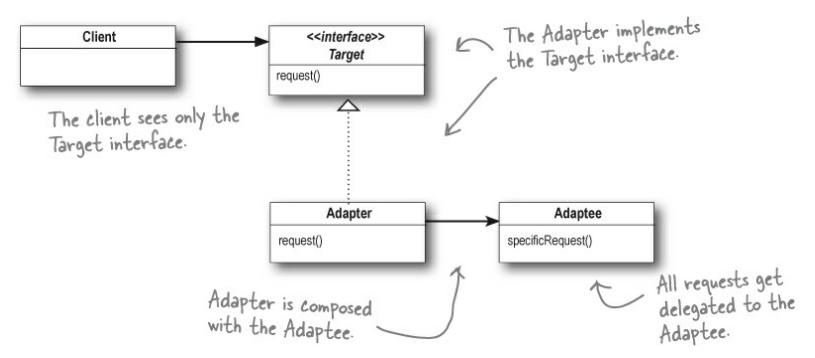The Adapter Pattern converts the interface of a class into another interface the clients expect. Adapter lets classes work together that couldn't otherwise because of incompatible interfaces.
The Adapter Pattern is used when an existing adaptee class is needed and its interface is not the one a client needs. For this, the pattern changes an intefcace into one a client expects using a adapter class. To achieve this, there are two forms of the Adapter Pattern: object and class adapters. Class adapters require multiple inheritance. They inherit from the adaptee and the target interface, which is expected by the client. With the object adapter, the adapter implements the target interface and wraps the adaptee by holding an instance of it.
The client is implemented against the target interface and uses the adapter in the following way:
- The client makes a request to the adapter by calling a method on it using the target interface.
- The adapter translates the request into one or more calls on the adaptee using the adaptee interface
- The client receives the results of the call and never knows there is an adapter doing the translation.

Another way to implement an adapter in programming languages that support multiple inheritance like C++ is to let the adapter class inherit both the target interface and the adaptee. This is known as Class Adapter. An Object Adapter uses composition to pass requests to an Adaptee.

Adapters are similar to the Facade Pattern and the Decorator Pattern. An adapter wraps an object to change its interface, a decorator wraps an object to add new behaviors and responsibilities, and a facade “wraps” a set of objects to simplify.
The following example uses modified classes found in the example of the Strategy Pattern. Here we have the following classes. A Duck interface acting as the target interface that a client expects to see:
public interface Duck {
public void quack();
public void fly();
}An implementation of this target interface is the MallardDuck:
public class MallardDuck implements Duck {
public void quack() {
System.out.println("Quack");
}
public void fly() {
System.out.println("I'm flying");
}
}The object that we are going to adapt, the adaptee, is the following Turkey class:
public interface Turkey {
public void gobble();
public void fly();
}A concrete implementation of this interface is WildTurkey:
public class WildTurkey implements Turkey {
public void gobble() {
System.out.println("Gobble gobble");
}
public void fly() {
System.out.println("I'm flying a short distance");
}
}The followign main program uses adapters to adapt a Turkey to a Duck:
public class DuckTestDrive {
public static void main(String[] args) {
MallardDuck duck = new MallardDuck();
WildTurkey turkey = new WildTurkey();
Duck turkeyAdapter = new TurkeyAdapter(turkey);
System.out.println("The Turkey says...");
turkey.gobble();
turkey.fly();
System.out.println("\nThe Duck says...");
testDuck(duck);
System.out.println("\nThe TurkeyAdapter says...");
testDuck(turkeyAdapter);
// Challenge
Drone drone = new SuperDrone();
Duck droneAdapter = new DroneAdapter(drone);
testDuck(droneAdapter);
}
static void testDuck(Duck duck) {
duck.quack();
duck.fly();
}
}The adapter that is used here converts a Turkey to a Duck. Therefore it needs to implement the target interface Duck.
It has a reference to its adaptee, the Turkey, which is initialized through the constructor. The class implements the methods of its target interface using the adaptee reference:
public class TurkeyAdapter implements Duck {
Turkey turkey;
public TurkeyAdapter(Turkey turkey) {
this.turkey = turkey;
}
public void quack() {
turkey.gobble();
}
// To fly the same distance as a duck, a turkey needs to fly five times as much
public void fly() {
for(int i=0; i < 5; i++) {
turkey.fly();
}
}
}The output of the program is:
$ java DuckTestDrive
The Turkey says...
Gobble gobble
I'm flying a short distance
The Duck says...
Quack
I'm flying
The TurkeyAdapter says...
Gobble gobble
I'm flying a short distance
I'm flying a short distance
I'm flying a short distance
I'm flying a short distance
I'm flying a short distanceAnother real-life example is to use an adapter between Java iterators and enumerators.
In Java, early collection types (Vector, Stack, Hashtable, and a few others) implement a method, elements(),
which returns an Enumeration. The Enumeration interface allows you to step through the elements of a collection
without knowing the specifics of how they are managed in the collection.
public interface Enumeration<E>
{
public bool hasMoreElements(); // Tells if there are any more elements in the collection
public E nextElement(); // Returns the next element in the collection/enumeration
}In later versions of Java this was replaced with Iterators which has also a remove() method:
public interface Iterator<E>
{
public bool hasNext(); // Tells if there are any more elements in the collection
public E next(); // Returns the next element in the collection/iteration.
public void remove(); // Removes from the underlying collection the last element returned by this iterator
}To deal with legacy code, that exposes the Enumeration interface, yet we’d like for our new code to use only Iterators.
An adapter to deal with this situation would need to implement the Iterator as its target interface and be composed with
Enumeration as its adaptee:
public class EnumerationIterator implements Iterator<Object> {
Enumeration<?> enumeration;
public EnumerationIterator(Enumeration<?> enumeration) {
this.enumeration = enumeration;
}
public boolean hasNext() {
return enumeration.hasMoreElements();
}
public Object next() {
return enumeration.nextElement();
}
public void remove() {
throw new UnsupportedOperationException();
}
}The hasNext() and next() methods are straightforward to map from target to adaptee: we just pass them right through. The best we can do for remove() is to throw a runtime exception because Enumeration does not support removing.
The following code test the above EnumerationIterator adapter:
public class EnumerationIteratorTestDrive {
public static void main (String args[]) {
Vector<String> v = new Vector<String>(Arrays.asList(args));
// Pass old style Enumeration to the adapter
Iterator<?> iterator = new EnumerationIterator(v.elements());
// Now we can use the new style Iterator methods
while (iterator.hasNext()) {
System.out.println(iterator.next());
}
}
}Reference
Buy
The code examples for the single patterns are from the book Head First Design Patterns and can be found on their GitHub page.

Comments